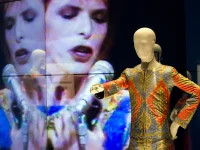Medias. Playboy trades nipples for good design

SEXY. After 60 years of brazen nakedness, Playboy’s March issue is safe for work. Or rather, it’s somewhat suitable for work. It really depends on where you work.
Either way, the photographs in the storied men’s magazine are much tamer. So much tamer, in fact, that this month’s issue doesn’t even come shrink-wrapped. Instead, it comes with a matte cover and in a slightly wider size, like an art magazine. See, Playboy now aspires to deliver a no-shame reading experience. It’s one of the main reasons the magazine just underwent a major redesign that, among other things, ends the publication’s decades-old tradition of running photographs of nude women in its pages.
“When the announcement came out,”—in October—“I definitely got texts and emails that were like, ‘what the fuck, what are you guys doing?’” says Mac Lewis, Playboy’s creative director. That’s understandable. Since its debut in 1953 (the same year Marilyn Monroe posed for the magazine’s first centerfold), Playboy has been one of the most famous sources of nude photography in the world. Or, at least, it was. Then the Internet arrived and made nudity—and a lot more—instantly accessible. Today, nakedness has long since ceased to be rare. John Mayer may have said it best, in Playboy’s own pages: Thanks to online porn, he mused, back in 2012, “there have probably been days when I saw 300 vaginas before I got out of bed.” Perhaps it was inevitable that just a few years later, Playboy chief executiveScott Flanders would tell The New York Times that nudity is “just passé at this juncture.”
Put a little differently, it’s not enough to fill a magazine with pictures of naked bodies. Today’s adult audiences expect some imagination from their mature content—a fact reflected by the proliferation of indie publications like C-Heads, or Adult magazine. “I don’t like the dualism between the higher and lower organs, brain and genitals,” says Sarah Nicole Prickett, Adult‘s founder and editor. “We all know from activities like sexting, you know how connected these things are. And yet these connections were hardly explicit in the culture around me.”
By “the culture,” Prickett is referring in part to the old guard of print porn—magazines like Penthouse, Hustler, and, yes,Playboy. Prickett launched Adult in 2012, as something of an antidote to these titles and their ilk. The magazine features stories, in addition to photos, which describe nuanced, maybe even subversive, accounts of modern sexuality. Notably, women create much of Adult’s content. The same goes for C-Heads, an alt magazine Lewis says is doing well and wielding some artistic influence in the space. These titles look and feel more like art magazines than anything you’d call porn, and belong to a wave of new erotic publications that prize good design. The Swiss1 magazine Glory Hazel, founded by two female designers, is another. Its pornographic mission: “…to approach this aesthetically neglected visual field with sensual creativity and innovation… to playfully discover its unknown potential… [and] to create an aesthetically appealing, humane representation of sexual fantasies.”
Time for A-Changin’
The taste of Playboy’s readership isn’t the only thing that’s changed. Like many magazines, Playboy’s profits have been declining steadily for years. Sales peaked in 1972, when the November issue sold 7.16-million copies. By 2015,Playboy‘s annual circulation was just 800,000.
Then, in 2014, something interesting happened. In August of that year, the editors re-launched Playboy’s website as suitable for work, and viewership shot up 400 percent, from 4 million unique views in July to 16 million in December. At the same time, the average age of site visitors dropped from 47 to 30.5.
If the website redesign was any indication, the time had come for Playboy to change—not just as a magazine, but as a brand. In the newly reincarnatedPlayboy, which hit newsstands last week, the women often still appear undressed. But there’s no nudity—at least, according to Instagram’s standards. There are no nipples, and certainly nothing revealing what panties otherwise hide. Women can even be found covered up, in nude-colored leotards, in t-shirts, and by bedsheets. There’s no denying it’s a more demure approach.

It’s also just one component of the redesign. Playboy’seditorial staff could have easily changed the photography without overhauling the rest of the magazine, but it would have been all wrong. The no-nude policy signaled a more sophisticated editorial direction, and the redesign needed to reflect it. To do that, Playboy’s scrapped a lot of its old rubrics. The editors threw out the dated cartoons, the front-of-book pages featuring a slew of products, and the centerfold data sheets that once listed the model’s measurements and favorite colors. Playboy even hired all new photographers, illustrators, and writers. “This was a clean slate,” Lewis says. “At first, it was really about breaking apart that skeleton and figuring out how we would do it the new way. As the ideas developed, you could start to see the cleanliness that we wanted.”
Lewis and his team ran through about 10 versions of the new layout, searching for a sharper, minimalist look. The design they settled on, which you’ll find in the March issue, reverts to the three-column treatment found in vintage Playboys. It also avoids what Lewis calls “the mishmash of 10 different typefaces, which Playboy was famous for in the past.” For headlines and subheads, it sticks to one typeface—a custom font Lewis commissioned from Okay Type. It’s a twist on Playboy’s longstanding wordmark, a thin, white outline of which appears on the cover of the March issue. Lewis says using a heavy, expressive font, especially one so laden with the brand’s identity, made it easier to keep the rest of the layout clean.
The Aesthetic Side of Sensuality
The decision to tidy up its layout could improve the experience of Playboy’s readers. “When I look at [the new Playboy], I feel this big ‘Aahhh.’ It’s relaxing,” says Moshe Bar, director of the Cognitive Neuroscience Lab at the Leslie and Susan Gonda Multidisciplinary Brain Research Center in Israel. The nascent field of neuroaesthetics doesn’t have a lot to say about how the brain deals with beauty and other socially malleable things, but preliminary findings from researchers like Bar suggest the human brain may finds curved objects—like buildings, floss canisters, watches—more attractive. He hasn’t investigated how our brains react to layout design, but he has studied the way our minds respond to complexity. “An interesting phenomenon is a U-shaped function, where, if something is too simple, it’s boring, and, if something is too complex, it’s hard to enjoy. The key word is clutter,” he says, referring to Playboy’s decision to get rid of it. “One thing we know really stresses people is clutter.” By striking the right balance between simplicity and chaos, designers can help maximize a reader’s ability to enjoy the product.
The magazine’s new typeface could also help with public reception. Sarah Hyndman is a graphic designer who runsexperiments on how we emotionally perceive typefaces. After looking at Playboy’s new typeface, she says block slab serif fonts typically read as masculine, but that, in the context of lots of spare, white space, it connotes a sense of prestige. The decision to outline the magazine’s wordmark in fine, white lines, she says, also makes the March issue appear more expensive.
Other erotic magazines—like Glory Hazel, Lui, and 25—follow similar design rules. (Adult‘s design is a bit different; Berkeley Poole, who did the design, says that in order to match the layered concepts in the magazine she was “strongly against the sterile expanses of white space and perfect (and oft anemic) type that is so pervasive in the editorial world.” Still, though, it’s got a clean and romantic look to it.) No one I spoke with went so far to say that typography or a new layout could lead to physical, sexual arousal—it’s not like there’s a typeface that can give a man an erection—but these design elements could induce responses that run adjacent to arousal, like relaxation, perceived attractiveness, and intrigue. As magazines likePlayboy decide to display flesh more judiciously, you can expect them to rely on other design decisions to convey an air of sensuality and sophistication.
Not that the girls don’t matter. They do. But now, Lewis says, Playboy is attempting to cast and portray women in a way that feels multidimensional. They still play into a fantasy, for sure, but if Playboy gets it right, the fantasy can be an intelligent one—maybe even one that women readers can dig, too. This initiative means introducing more than fonts and lots of white space; it means showing off myriad body types and definitions of beauty—something data suggests Playboy hasn’t historically done so well. Still, the minimal look supports that goal. Most pages in the new issue feature just one well-lit but untouched photo. These veer towards the more expressive, eschewing the stock poses from past issues. In articles that feature multiple photos of the same model or actress, each image tends to vary in setting, style, and mood from the others, “rather than the six pictures in a row of the same girl turned around in positions, with the airbrushing and the lighting,” Lewis says. “Yes, it’s more artistic, but it’s also more realistic.”
1UPDATE 1:10 PM ET 02/18/16: An earlier version of this story misstated the nationality of Glory Hazel and its creators. We regret the error.










